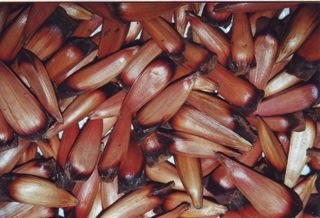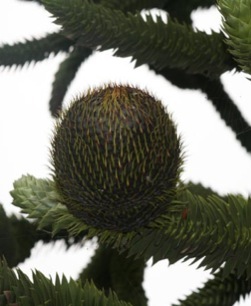Lunch Drops In
My good friend Saul is a luthier, a man who works with exotic woods. He repairs premium wooden instruments. It is not unusual for him to be working on a Stradivarius or a Guarneri someone sat on. And for 30 years he thought the tree right outside his shop was a Monkey Puzzle Tree, Araucaria araucana (air-ah-KAIR-ee-uh air-ah-KAY-nuh.) That’s what it was sold as. It’s not. It’s a close relative, the Bunya Pine. The falling cones from either, however, can still injure you.
The Monkey Puzzle Tree is from Central Chile and Argentina. But, it’s a common landscape plant in Florida and southern border states all the way to California then up the west coast. It is also cultivated in England and Ireland, In fact the tree’s name came from an incident in England’s Cornwall in 1850. The tree back then was rare in gardens and not widely known. The owner of a young tree at Pencarrow Garden was showing it off to a group of friends when one said “It would puzzle a monkey to climb that.” At the time the tree had no common name in English. It was first called the ‘monkey-puzzler’ tree but ‘monkey-puzzle tree’ eventually caught on.
The point has been made that any monkey trying to climb the tree would likely be injured. Its leaves are more like ferocious reptilian spines than leaves. And, monkeys don’t live in the tree’s native range. However, dinosaurs did some 250 million years ago and there is some speculation that the ancient tree’s armament was to dissuade dinosaurs from lunch. Most surprisingly, it’s in the Pine family closely related to the Norfolk Pine, Araucarua excelsa (air-ah-KAIR-ee-uh eck-SELL-suh.) Like the Natal Plum and Chinese Elm, it’s an easy-to-find tree in temperate suburbia. They’ll be around for a while because some are at least 2,000 years old or more.
While found mostly among southern border states the tree is actually hardy and prefers cooler climates with some nice specimens in the Pacific Northwest states and British Columbia. It is a favorite display tree in Great Britain and grows well in Australia and New Zealand. It does, however, take a male and a female tree to produce cones and seeds, usually a ratio of seven ladies to one fellow but I’d plant two guys just in case. The delicious seeds are edible raw or cooked. They are rich in starch and resemble an almond in size with a slight flavor of pine nuts.
The official tree of Chile, it was first found by outsiders the 1780s. It was named Pinus araucana 1782. By 1873, after a lot of botanical arguments, it became Araucaria araucana. The name Araucana comes from the native Araucano People who used the seeds of the tree in Chile. Sadly its numbers are dropping in its native range and has been protected since 1990.
Lastly, the seeds of the Araucaria bidwillii, (air-ah-KAIR-ee-uh bid-WILL-ee-eye) a native of Australia, are also edible.
Green Deane’s “Itemized” Plant Profile
IDENTIFICATION: Pyramid-shaped tree 90 to 130 feet tall, 3 to 4 feet in diameter. The branches grow horizontally in whorls of five in opposite pairs, drooping, stems brittle, bark corky; feathery leaves, pale green, compound, tripinnate; The leaf is an armor-like scale, triangular, oval to lance shape, 1 to 2 inches long, shiny green on both surfaces but surface marked with longitudinal lines, RAZOR SHARP. Male and female flowers. Male cones and female cones. Female cones are large, round, dark brown, develop in two to three years, 4 to 7 inches long, 3 to 6 inches wide, falloff at maturity; split in three when dried, 200 seeds are brown to orange, triangular in shape with papery wings, 1 to 1 1/2 inches long, the nut is long and narrow with 2 small even wings that are denticulate at the top.
TIME OF YEAR: When ever you find thefemale cones on the ground.
ENVIRONMENT: Prefers well-drained, slightly acidic, volcanic soil but will tolerate almost any soil type. It produces the heaviest where there are cool summers.
METHOD OF PREPARATION: Seeds, raw or cooked. They can be boiled or roasted. Ground, they make a good flour substitute.
HERB BLURB
Resin from the tree is used to treat wounds and ulcers.



